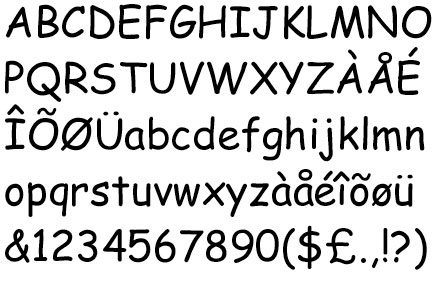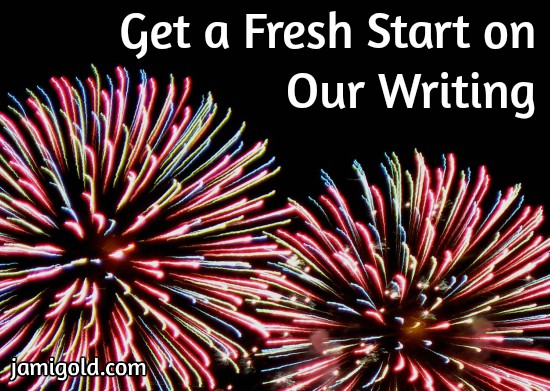Yay! We survived another year! I don’t know about you, but sometimes that goal feels rather iffy during the year, so yes, surviving is an accomplishment. *smile*
The New Year is a time of wrap-ups and resolutions. We might make a list of our favorite books or review our accomplishments of the previous year. Or we might think about what we can improve over the upcoming year.
I try to avoid making myself feel guilty by thinking of all the things I didn’t do last year. And I’m also not one for making New Year’s Resolutions that never survive the month of January.
Instead, I focus on the positive side of moving forward, like seeing the New Year as a blank page on which we can create a new story for our life. In other words, I like the idea of fresh starts.
So I loved a writing tip I saw just before leaving for the annual Christmas visit to my brother’s house. I wish I could give credit to the person who came up with the idea, but I saw it discussed in multiple Twitter threads, so I’m not sure who or where it started. Basically, the ideas is to draft our story in a different font than usual to help us see everything with fresh eyes.
The Difference a Font Can Make
Years ago, I shared some of the ways we can give ourselves “fresh eyes” for editing our story. Beyond the usual suggestions like setting our work aside or getting feedback, I also mentioned that we can literally change the look of our words.
We can change the look of our words by:
- printing out our story,
- sending the file to our Kindle or other ereader, or
- changing the font in our word processing file.
For me, the last option is the easiest to do (and saves trees *smile*), as we can just Select All and choose a new font. I’ve found the font-change technique helpful for reading and editing my work as “new” overall because the different format doesn’t match my visual memory.
But what if we could double that effect by using a special drafting font? We could theoretically use one font for drafting, another for editing, and yet another for proofreading, giving us fresh eyes throughout the whole process. The question then is, what font should we use for drafting?
What’s the “Best” Font for Drafting?
Just as with anything labeled “best,” the answer is somewhat subjective, as we all have different measures.
We might prefer…:
- drafting and/or editing in a format that resembles our finished story
- sticking to the basics so we don’t have to clean up any oddities before sending our manuscript to editors or agents
- changing things up with different fonts
For myself, I have an odd form of near-photographic memory related to spatial relations that makes it very difficult for me to see my story with fresh eyes. That means a change of font works as a fantastic “reset” button.
Still, I was surprised by the font mentioned in those Twitter threads the other week. Their recommendation? …Comic Sans. *smile*
Comic Sans? We Can’t Draft in That, Can We?
If you’re familiar with the impressions of different fonts at all, you might have heard the debate about Comic Sans. Yes, Comic Sans, the font that looks like handwriting.

(Actually, I’d be lucky if my handwriting were that neat, but that’s neither here nor there. *grin*)
How might the Comic Sans font help us draft our story? (Seriously!) Click To TweetComic Sans has been called the World’s Most Hated Font. The insults include: child-like, overused, impossible to take seriously, too-often used inappropriately, etc.
The vast majority of the hatred comes from how people use the friendly, playful, casual font in situations that don’t mesh with its vibe, such as the Vatican’s retirement photo album for Pope Benedict XVI (yep, that happened!). Yet at the same time, Comic Sans has been recognized as one of the best fonts for people with dyslexia or for improving reading comprehension overall.
Both of those reasons hint at why it might be the perfect font for our drafting:
- Tend to typo sound-alike words when drafting? The distinct lettering that works so well for dyslexia and reading comprehension might also help us spot those typos.
- Struggle with getting the words “just right” when drafting? Comic Sans is casual, so it might help us not take our crappy first draft too seriously, like sketching out our story before we “commit” to our words with a more professional font in later drafts.
- Not a Comic Sans hater (or even like it)? The fun and friendly nature of the font might help us enjoy drafting our story.
Obviously, drafting and publishing are far different things, with many editing steps in between. In other words, drafting in Comic Sans isn’t unprofessional or something to be avoided, even if we usually hate the font.
While we usually wouldn’t want to publish in the font, during our drafting process, using Comic Sans in our word-processing software might help us put words on the page. Then if we change our file to a different font for editing, we’ll automatically get the benefit of seeing our story a whole new way. Both can help us get a fresh start on our story. *smile*
Does changing fonts help you see your story differently for the editing process? Have you thought about using a different font for the drafting process as well? What do you think of the idea of using Comic Sans for drafting (or is there another font you’d like to try)? Do you think the idea of “sketching” out our words might help, or can you think of other benefits of using a non-professional font? (And if you know where the idea to use Comic Sans for drafting originated from, let me know!)

